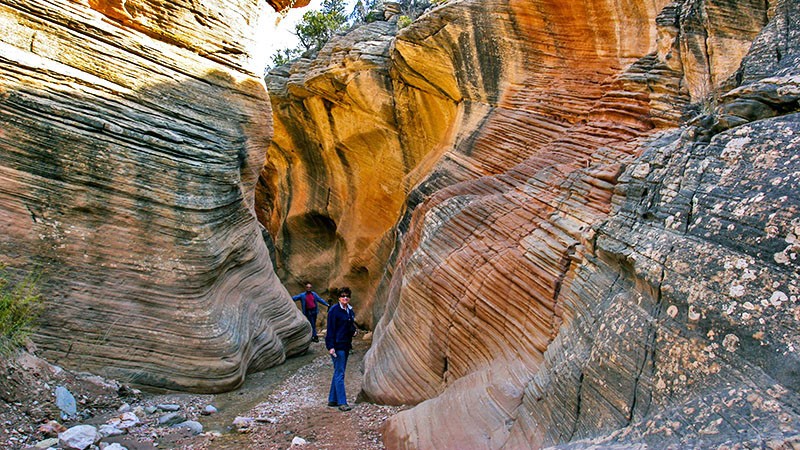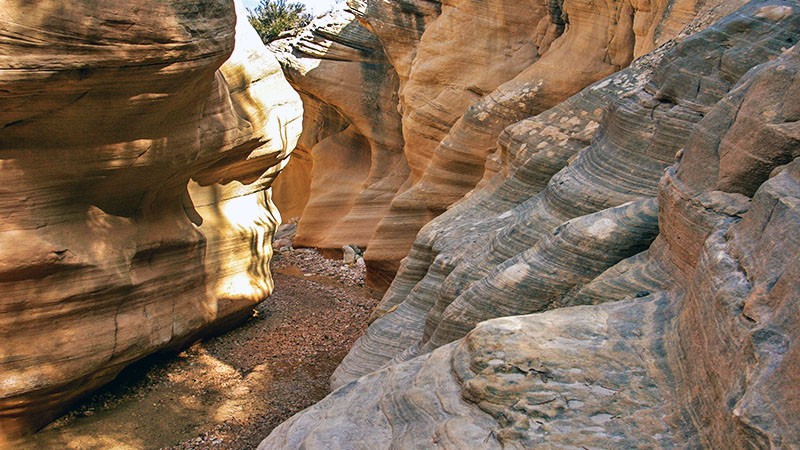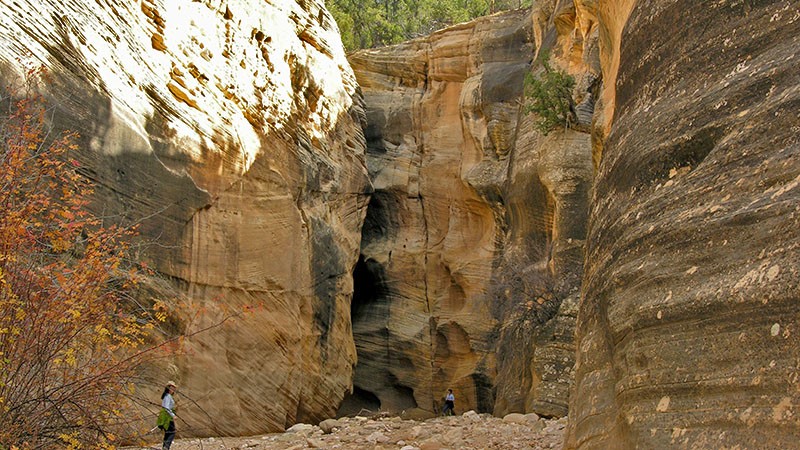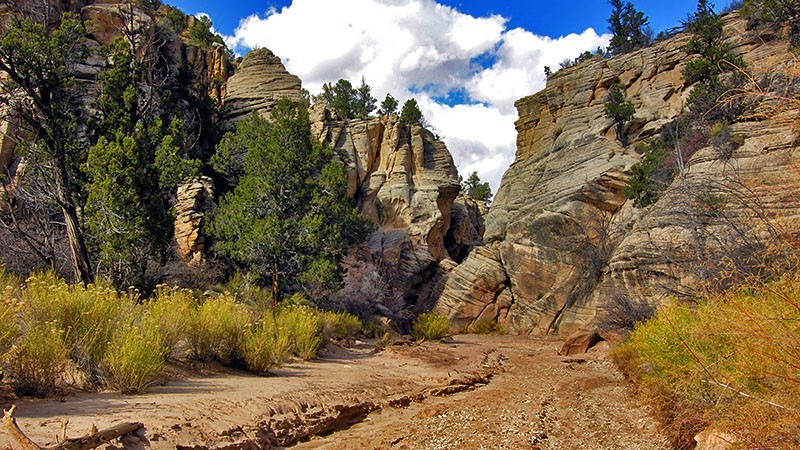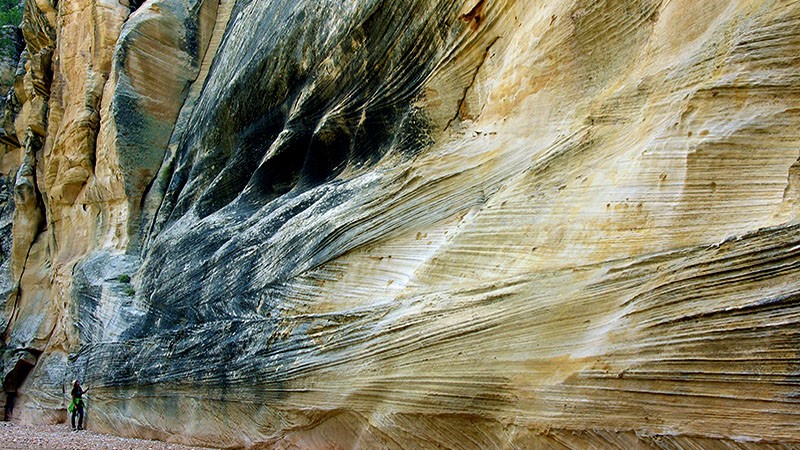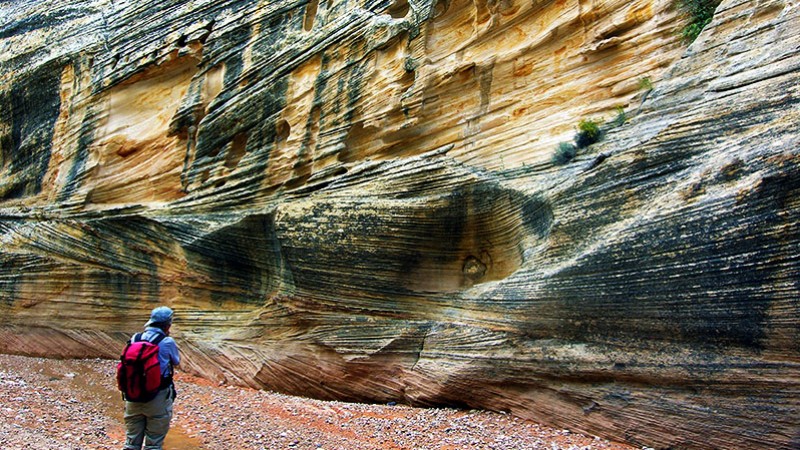Willis Creek Slot Canyon
If you are visiting Bryce Canyon National Park and would like to experience something different, then we recommend visiting delightful Willis Creek Slot Canyon. When you go, you will see first hand how this small creek created a stunning geologic dreamland.
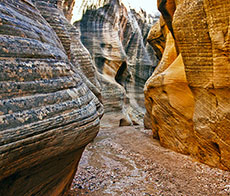

Hiking Willis Creek Slot Canyon is easy. Of all the slot canyons that we’ve been to in the Southwest (and there have been dozens), this one, by far, gives you the most bang for your buck. It’s easy to get to and, even though it requires driving on a dirt road, a standard automobile should have no problems. And, unlike other slot canyons, you simply walk into it from where you park your car – no ropes, ladders or rock scrambling.
In most slot canyons, photographers are challenged with the high contrast of lighting conditions. This is not the case with Willis Canyon. Although it’s deep and skinny, the narrow sections are not very long allowing ample light to come in. This allows even an amateur to take great pictures.
Getting There
Willis Canyon is located 9 miles south of Cannonville, Utah. To reach Cannonville from Bryce Canyon (at the junction of Hwy 12 and the road into Bryce), drive east 12 miles (19 km) on Hwy 12, through the town of Tropic, to Cannonville (which is located on the right or south of the highway). If you are coming from the town of Escalante in the east, Cannonville is reached by driving west on Hwy 12 for 34 miles (54 km).
Once in the small town of Cannonville, drive a short distance south from Hwy 12 on Main Street and, on the right, stop in at the BLM visitor center. Here you can inquire on the road conditions to Willis Canyon and learn about the other places of interest to visit in this area including Kodachrome Basin and Bull Valley Gorge.
After stopping at the visitor center, continue south on Main Street which turns into the main road to Kodachrome Basin. After about 2.8 miles (4.5 km) from Canonville, turn right onto a well-maintained dirt road which leads off to the southwest. Continue on this road for a little over 6 miles (10 km). At about 5.5 miles (8.8 km), the road will descend into a wide canyon. At the bottom and before crossing the creek, look for a small parking area on the right which also doubles as a small campground. Park your vehicle here.
The Hike
The best part of Willis Creek’s narrows are seen while walking one mile downstream from the parking area. After the first canyon confluence, the canyon becomes bigger and less narrow. Although there are no more narrows after a mile, it’s still very scenic for a few more miles. If you’re only interested in seeing the narrows, it’s an easy two mile, one-way hike.
From the parking area, enter the small creek from the road crossing. Hike down-canyon (east) along the right side of the creek to go around a short waterfall. Soon, you will need to step down into the shallow canyon which is no more than 3-4 feet (1 meter) deep at this point. There’s also a bypass trail that you can use to hike around this obstacle. It is found about 40 feet (20 m) north of where the road crosses the creek.
More…
Pictures
Below are some pictures of what you will see along the way.
Shop for Escalante items
Scroll down to see and shop for items related to Grand Staircase-Escalante National Monument from Amazon.
Books Recommended on Amazon
Virtual Tour on YouTube
After you step down to the creek, be sure to walk back upstream for a short distance. You will find a small waterfall that has created small but mesmerizing sculptures in the red sandstone.
Every time we’ve hiked Willis Canyon, there was a small amount of water in the creek. It was not more than a foot or two wide and was easy to step or hop over. Hopefully when you hike the canyon, your feet won’t get wet! Since the drainage of Willis Creek is no more than six miles (10 km) to the west, at the ridge of Bryce Canyon, large amounts of water does not normally accumulate in the canyon unless there has been a recent rainstorm.
Just downstream from the small waterfall and around a bend in the canyon, you will see a small preview of what’s to come. The canyon walls are beautifully sculptured from hundreds of thousands of years of water tumbling against the soft sandstone. Here, the canyon wall is only 10 feet (3 m) tall. The further you hike however, the deeper the canyon gets and the higher the walls become.
First Narrows
After hiking past a few bends in the canyon, you will come upon the first set of narrows. The walls here are about 20-30 feet (6-9 m) tall and the canyon’s width is no more than 10 feet (3 m) – narrow enough to be exciting, wide enough to not be intimidating! These narrows last for several hundred feet and then the canyon suddenly opens up.
These first narrows last for a good distance. The canyon then immediately opens up which brings an ample amount of light into the canyon’s narrows. While walking along the entire canyon, remember to look up at the rock formations and vegetation near the canyon’s rim.
After hiking past another bend or two in the canyon, you will encounter a section where the creek is eroding into a large open slab of sandstone. Here you will witness slot canyon creation in progress. Also at this point, you may need to find a safe path to descend this slab of sandstone.
Second Narrows
Right after this point, the canyon enters the second narrows. It isn’t as narrow as the previous but still contains more stunningly sculptured and colorful walls. The canyon opens up again briefly and then enters the third narrows.
The third narrows are the deepest in the canyon. Claustrophobic people might feel a little uneasy walking through here as it is only 6-8 feet wide and over 100 feet (30 m) deep! For those of us who don’t mind tight places, it is awesome! When walking through the narrows, remember to look up at the amazing rock sculpturing that Mother Nature has done.
Averett Canyon
After exiting the narrowest part of the canyon, you will enter a much wider section of the canyon. Soon, you will reach the confluence of Averett Canyon on the left. If you turn left and hike a small distance up Averett Canyon, a dry water will block any further exploration.
You can now continue down Averett/Willis Canyon for as long as you wish. There are no more narrows to encounter. However, every bend in the canyon presents new dazzling formations etched out in the canyon walls. So while you are looking forward while hiking down the canyon, don’t forget to stop occasionally and look up at the canyon walls.
After about a mile from the confluence of Averett and Willis Creeks, the confluence with Sheep Creek is reached. If you continue hiking down the canyon, you will eventually reach Paria Canyon in about 3.5 miles (5.6 km). Paria Canyon is a major drainage in the area east of Bryce Canyon National Park and is a major tributary of the mighty Colorado River.
When you return to your vehicle, since you’ve made it this far on the dirt road, you may wish to continue south on the road for another mile and a half (3.1 km) to visit Bull Valley Gorge. The road crosses over this very deep and narrow slot canyon. When you get out of your vehicle to take a peek into the canyon, it is very scary indeed! Once you are done looking, turn back towards Willis Canyon to return to Cannonville and Hwy 12.
Trip Map
Make sure to zoom into the area of Willis Canyon to see the detail. Look for the cluster of pins at the bottom of the map.
Support Us
Help us fill up our tank with gas for our next trip by donating $5 and we’ll bring you back more quality virtual tours of our trips!
Your credit card payment is safe and easy using PayPal. Click the [Donate] button to get started:

